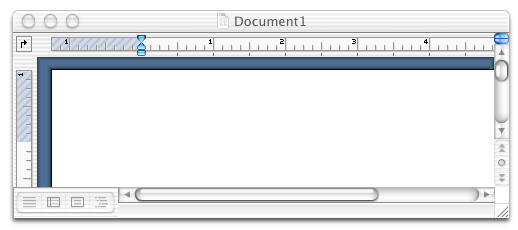
 |
Links for K-12 Teachers | Assessment Assistance | On-Line Practice Modules | Daily Dose of the Web
Managing Windows in Mac OSX
"Ooey Gooey!" Did you ever say that as a child? Well right now you are taking advantage of a GUI (pronounced gooey). The browser window, and all of the other windows you open on your computer, are part of the Graphical User Interface that has made computers so accessible to a huge number of users. Learning how to manage these windows will help you use your computer with less frustration.Components of a window - This image is clickable. To learn more about one of the identified regions, put your mouse cursor over the region. When you see your cursor change to a finger, gently click one time with the left mouse button.

Title Bar - This title bar contains the title of the document you are currently working on or viewing. In the example above the name of the document is Document1. That means it has not yet been saved. The title bar is also the move bar. To move a window, place your mouse pointer in the title bar, click with the mouse button, hold the button down and move the mouse. The window moves to a new place on the screen.
- Active or Inactive windows - The title bar also indicates which window is active. Yes, you can have more than one window open on your screen. That is why you bought so much memory! However, even if you have 20 windows open, only one window will be active.
- Inactive window - If the three control circles (upper left corner) are gray the window is inactive and you can not work in it. No keyboard commands related to the window will function, because it is inactive. You can make an active window inactive by clicking anywhere outside the boundary of the window.

- Active window - The three colored control circles in the gray title bar (upper left corner) indicate that a window is active. No matter how many windows you have open, only one of the open windows will have those three colored circles in the title bar. You can make an inactive window active by clicking anywhere inside the boundary of the window.

Minimize - Occasionally you will want to see something on the desktop of your screen. If you are not finished with the window that is covering the desktop gently click one time on the yellow minimize circle. When you roll your cursor over the circle you see a minus sign. The window disappears from your screen, but it is not closed. You can see a thumbnail of the window in the dock. When you are ready to continue working in the window, gently click one time on the thumbnail in the dock and the window opens back up, ready for work.
Maximize - Click one time on the green control circle. As you roll your mouse pointer over the circle you will see a plus sign. One click will open the window so that it covers more of your screen area. Clicking on the green circle a second time will restore the window to its former smaller size.
Close - Yes! That's right, click in the red circle to close a window. If you are accustomed to working on a Windows based computer, you know that closing a window can exits from an application. This is generally not true about a Macintosh window. Closing a window leaves the application running. This can cause frustration for new users who try to open an application that is already open. For example; If you have only one Internet Explorer window open and close that the menu bar does not change. If you try to open IE again, nothing will appear to happen. IE is open without a browser window, because it was closed. Get in the habit of quitting applications from the File menu, rather than closing windows.
Scroll Arrows - These arrows allow you to move the contents of the window up, down, left or right.
- Gently click one time on any of these arrows to move the window a small increment.
- Click on one of these arrows and leave the mouse button depressed and the window will move continuously until you let go of the mouse button.
Scroll Slide - Place the tip of your mouse pointer directly on the Scroll Slide. Click on the slide, leave the mouse button depressed and move your mouse pointer up, down, left or right. The contents of the window will move with the slide.
Resize Corner - This bottom right corner of the window contains three diagonal lines. Follow the directions below to resize a window:
- Place your mouse pointer in the resize corner and it changes to a two headed diagonal arrow. Click with the left mouse button, hold the button down and move the mouse away from the center of the window to make both the height and width of the window get larger at the same time. If you repeat that step, but drag toward the center of the window, both the height and width get smaller. This does not work on any other part of the window.
Shut Down - There are two ways that I shut down my Mac; the traditional method of using a menu, and using a keyboard shortcut.
Traditional
Select the Blue Apple in the top left corner of your screen, slide your mouse pointed down to Shut Down... and click.
Hold down the control key and tap the media key (top right key on your keyboard)Task - Go to a practice page and follow the instructions you find there.
Mouse | Windows | Desktop | Built-In | Saving | Keyboard
 Custom Search
Custom Search
Visitors since November 2000
Memphis, TN
Internet4Classrooms is a collaborative project developed by Susan Brooks and Bill Byles
Return to Internet4Classrooms home